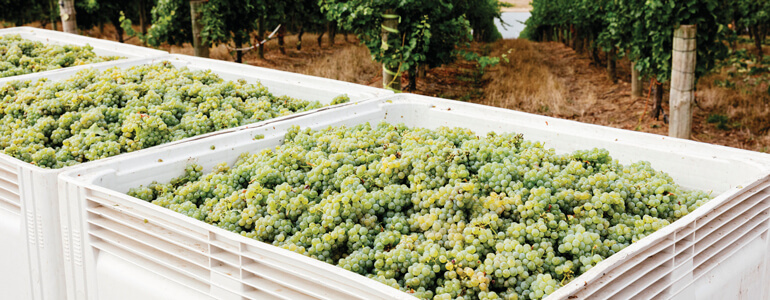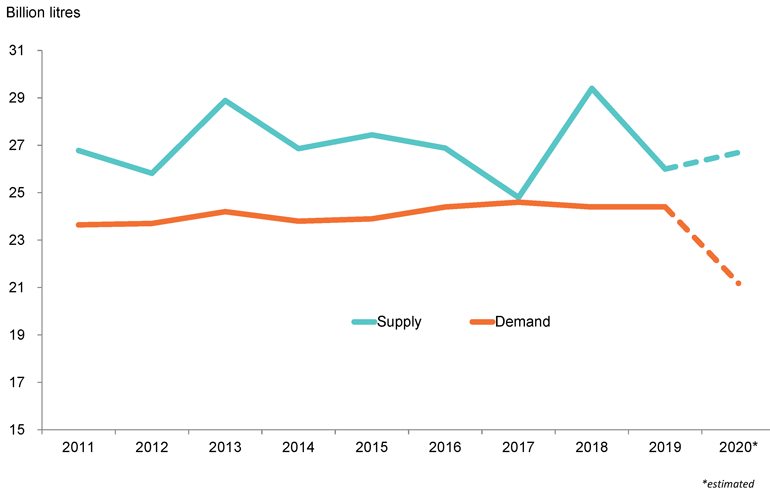While many activities around the world have been brought to a halt by the COVID-19 pandemic, grapegrowing and winemaking have continued. Grape picking has finished in the southern hemisphere, while fruit set is nearly complete in the northern hemisphere, with harvest approximately three months away. A quick look at the major wine producing countries suggests a mixed result for 2020, although it is too early to predict the northern hemisphere crops with any certainty.

Southern hemisphere vintage
The main southern hemisphere wine producing countries: Argentina, Chile, Australia, New Zealand and South Africa, were in the middle of picking when COVID-19 restrictions were rolled out to varying degrees in the different countries. Luckily, harvest was allowed to continue and was relatively unaffected apart from changes to work practices to ensure social distancing was maintained.
Overall, the 2020 harvest from the southern producers is expected to be lower than in 2019, mainly as a result of prevailing dry conditions.
Argentina has reported a crop of 2.04 million tons (approximately 1.98 million metric tonnes[1]), 11 per cent below the 2019 crop and 7 per cent below their five-year average, after a season affected by drought, frost, high temperatures and an early and compressed harvest.
Chile’s crop is expected to be down by 15-20 per cent compared with its average, after a frost event in early December and a very hot summer capped off the tenth successive year of below-average rainfall in the winegrowing regions. The International Organisation of Vine and Wine (OIV)’s preliminary estimate for Chile’s wine production is 1.05 billion litres[2].
Conversely, South Africa has had its best vintage since 2017 and is expected to produce 1.02 billion litres of wine after generally favourable conditions prevailed through the growing season, a welcome relief after two very difficult seasons. The crop is 5 per cent above last year’s, but still slightly below the five-year average.
New Zealand had a season described by the New Zealand Wine Directory as ‘benign’ and is expected to produce close to its average production of 0.3 billion litres according to the preliminary OIV estimate.
Australia’s official crush estimate (Vintage Report) is due to be released in July, but early indications suggest it will be below the 2019 vintage and the 10-year average. The growing season was affected by frost events, smoke and fire as well as ongoing drought conditions across some regions. However, access to supplementary water appears to have mitigated the effects of lack of rainfall in some regions. The early OIV estimate for Australia’s wine production in 2020 is 1.15 billion litres, 4 per cent below 2019 and 10 per cent below the 5-year average.

Northern hemisphere vintage
The northern hemisphere is moving into summer. To date there have been few reports of issues affecting crop potential, meaning that the major producers are on track for at least an average season. However, it is still early days.
California has had a very consistent harvest, producing close to 2.4 billion litres of wine, in all but one of the past 7 years. At this stage conditions are reported to be good across the state and therefore the 2020 crop is predicted to be at least average-sized, according to Ciatti[3].
France has reportedly had an uneventful spring and good rains in April – a contrast to the 2019 season where vines were damaged by spring frosts, drought and hail, and the production was 12 per cent below average. Ciatti reports that vines are ‘in good shape’ and vine development is running 2-3 weeks ahead of average on some varieties. While there is still potential for substantial losses due to heatwaves and other events during summer, at this stage it is reasonable to estimate an average-sized crop giving a total wine production of 4.4 billion litres.
Spain had good winter rains and avoided any significant frosts at critical times, meaning it also has the potential to produce an average or above-average sized crop. In 2019, its production was 11 per cent below the long-term average at 3.4 billion litres, but in 2018 it had a near-record production of 4.5 billion litres. Therefore, a mid-range figure of 4 billion litres is a reasonable estimate for 2020.
Italy has been the largest wine producer in the world every year since 2015. While it has reportedly had one of the hottest and driest winters in recent years, growing conditions in the 2019–20 season have been normal. A conservative estimate at this stage for Italy is 4.75 billion litres, the same as in 2019. This would be slightly below the five-year average of 4.9 billion litres.
A significant problem for these European producers is the amount of carry-over stock still in tanks, as a result of the decline in exports and domestic consumption caused by trade tariffs and lockdowns. This is likely to lead to a lack of storage for the 2020 wines, as well as weighing heavily on the market and depressing prices. European wine producers have asked the European Commission to approve a ‘crisis distillation’ program, to turn excess alcohol into products like hand sanitiser and cosmetics.

Global summary
Figure 1 shows the production estimate by country for 2020 compared with OIV figures for 2019[4]. Overall, the combination of a reduced harvest in the southern hemisphere countries and an average-sized harvest in the northern hemisphere would mean a near-average global harvest of 26.7 billion litres.
Figure 1: Production estimate for 2020 compared with 2019 by country

(source: OIV and Wine Australia)
How does estimated supply line up with expected consumption?
Since 2013, global wine consumption has remained fairly stable at around 24 billion litres, according to OIV figures. Total world wine consumption for 2019 is reported by the OIV as 24.4 billion litres[5].
The OIV does not provide forecasts, but the IWSR has just released its 2020 dataset, in which it forecasts global wine consumption over the next 5 years. In 2020, the IWSR forecasts that there will be a substantial decrease in consumption across the world as a result of the COVID-19 pandemic and associated economic and social impacts, with double-digit declines in all of the top 10 wine-consuming countries except the United States of America (USA). Figure 2 shows the result of applying the IWSR growth rates for 2020 to the OIV consumption figures for the top 10 wine-consuming countries in 2019, to produce an estimate for consumption in 2020. This approach has been taken rather than using IWSR forecast volumes by country to provide continuity with the OIV historical figures. There is no major variation between the IWSR and OIV figures in any case.
Figure 2: Wine consumption by country 2020 forecast vs 2019

(source: OIV and IWSR)
The total decline in global wine consumption in 2020 is forecast by IWSR to be 13 per cent. This would result in world wine consumption dropping to 21.2 billion litres and would mean that the gap between supply and demand (consumption), based on the supply estimates given above, would be 5.5 billion litres (21 per cent) – higher than it has been for at least 10 years (see Figure 3).
Figure 3: Global wine supply vs consumption (demand) over time

(source OIV, IWSR and Wine Australia)
The latest Wine Australia Global Supply Monitor (May 2020) can be downloaded here (available to Australian wine sector levy-payers and wine exporters only).

